Health Policy & Planning 12: Strategies for Obesity Reduction
VerifiedAdded on 2022/10/01
|15
|3200
|21
Report
AI Summary
This report addresses the challenge of obesity in Australia, proposing a health policy plan to reduce obesity levels through the implementation of a sugar tax. The introduction highlights the increasing prevalence of obesity and its associated costs, particularly the financial burden on the government due to healthcare and social welfare. The report proposes a 40% tax on sugary beverages as a primary strategy, aiming to discourage consumption, raise revenue for obesity prevention campaigns, and encourage healthier lifestyle choices. The report includes a SWOT analysis to evaluate the strengths, weaknesses, opportunities, and threats associated with the sugar tax policy. It also examines stakeholder analysis, identifying key participants such as the government, health organizations, beverage industry, and the public, and discusses their roles and interests. The report emphasizes the need for assessment tools to evaluate the effectiveness of the strategies, including the reduction of sugar consumption, government expenditure, and the impact of obesity. It prioritizes strategies based on effectiveness, efficiency, and cost-effectiveness, concluding with a recommendation to implement the sugar tax as a critical step in addressing the obesity crisis.
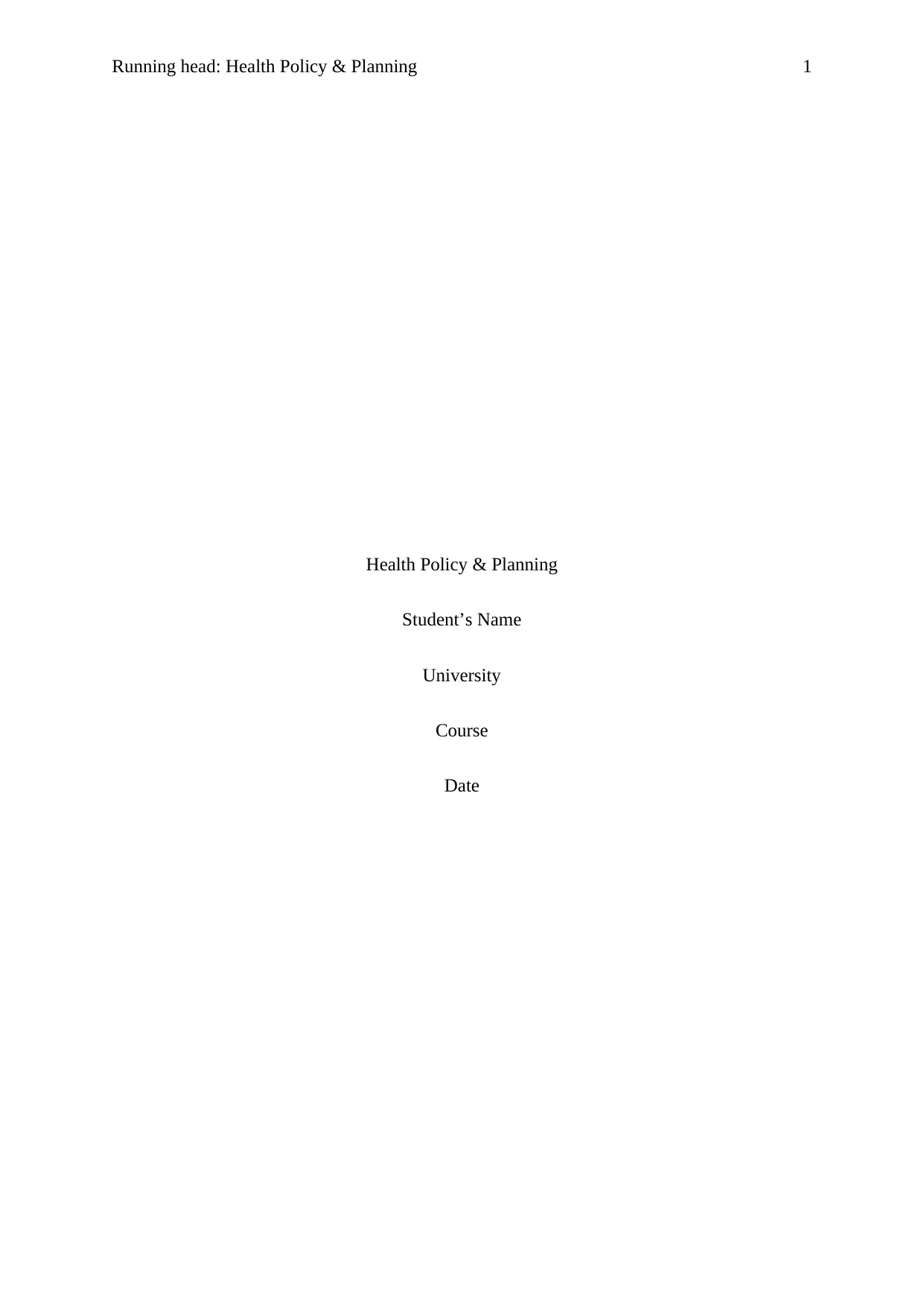
Running head: Health Policy & Planning 1
Health Policy & Planning
Student’s Name
University
Course
Date
Health Policy & Planning
Student’s Name
University
Course
Date
Paraphrase This Document
Need a fresh take? Get an instant paraphrase of this document with our AI Paraphraser
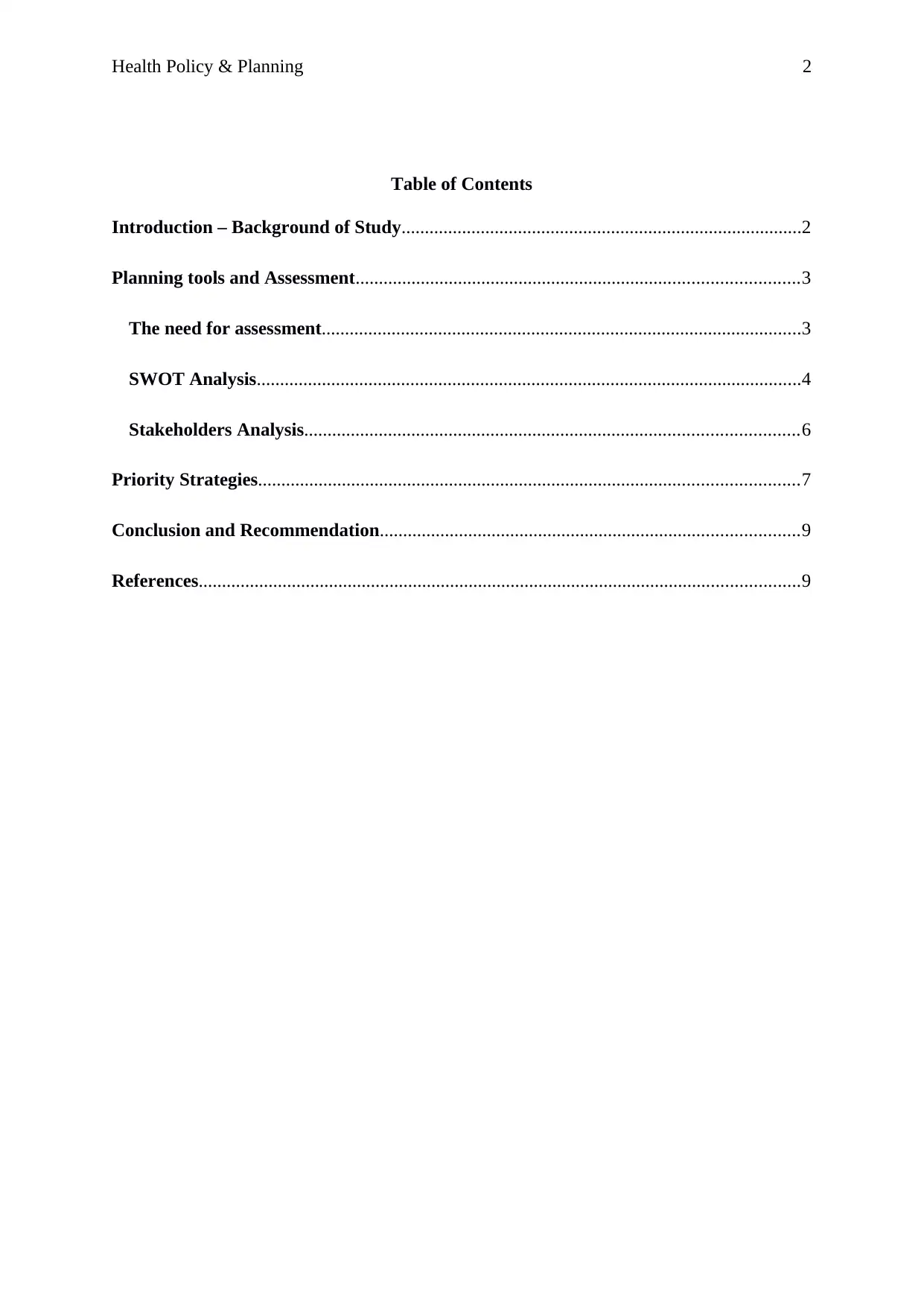
Health Policy & Planning 2
Table of Contents
Introduction – Background of Study......................................................................................2
Planning tools and Assessment...............................................................................................3
The need for assessment.......................................................................................................3
SWOT Analysis.....................................................................................................................4
Stakeholders Analysis..........................................................................................................6
Priority Strategies....................................................................................................................7
Conclusion and Recommendation..........................................................................................9
References.................................................................................................................................9
Table of Contents
Introduction – Background of Study......................................................................................2
Planning tools and Assessment...............................................................................................3
The need for assessment.......................................................................................................3
SWOT Analysis.....................................................................................................................4
Stakeholders Analysis..........................................................................................................6
Priority Strategies....................................................................................................................7
Conclusion and Recommendation..........................................................................................9
References.................................................................................................................................9
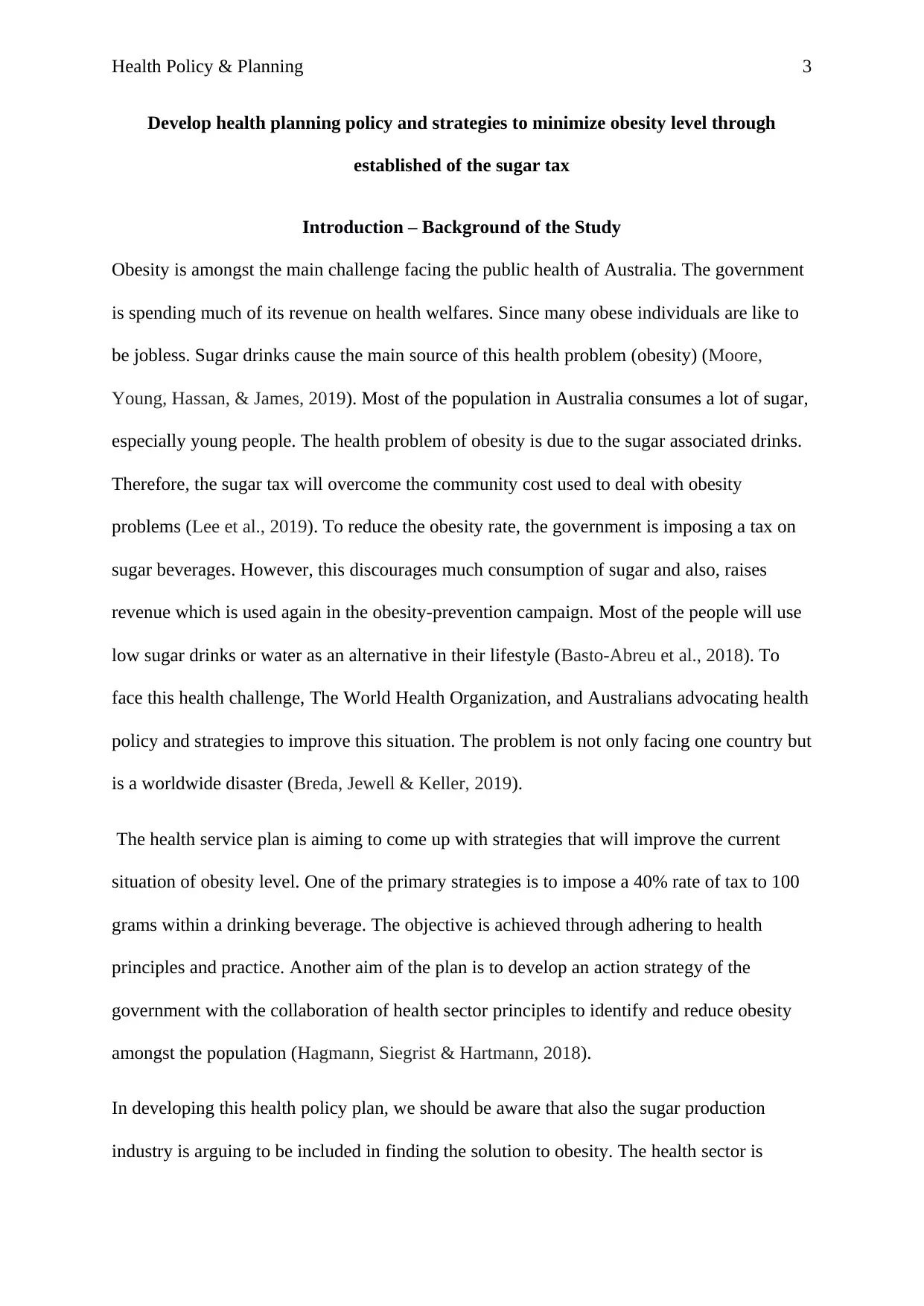
Health Policy & Planning 3
Develop health planning policy and strategies to minimize obesity level through
established of the sugar tax
Introduction – Background of the Study
Obesity is amongst the main challenge facing the public health of Australia. The government
is spending much of its revenue on health welfares. Since many obese individuals are like to
be jobless. Sugar drinks cause the main source of this health problem (obesity) (Moore,
Young, Hassan, & James, 2019). Most of the population in Australia consumes a lot of sugar,
especially young people. The health problem of obesity is due to the sugar associated drinks.
Therefore, the sugar tax will overcome the community cost used to deal with obesity
problems (Lee et al., 2019). To reduce the obesity rate, the government is imposing a tax on
sugar beverages. However, this discourages much consumption of sugar and also, raises
revenue which is used again in the obesity-prevention campaign. Most of the people will use
low sugar drinks or water as an alternative in their lifestyle (Basto-Abreu et al., 2018). To
face this health challenge, The World Health Organization, and Australians advocating health
policy and strategies to improve this situation. The problem is not only facing one country but
is a worldwide disaster (Breda, Jewell & Keller, 2019).
The health service plan is aiming to come up with strategies that will improve the current
situation of obesity level. One of the primary strategies is to impose a 40% rate of tax to 100
grams within a drinking beverage. The objective is achieved through adhering to health
principles and practice. Another aim of the plan is to develop an action strategy of the
government with the collaboration of health sector principles to identify and reduce obesity
amongst the population (Hagmann, Siegrist & Hartmann, 2018).
In developing this health policy plan, we should be aware that also the sugar production
industry is arguing to be included in finding the solution to obesity. The health sector is
Develop health planning policy and strategies to minimize obesity level through
established of the sugar tax
Introduction – Background of the Study
Obesity is amongst the main challenge facing the public health of Australia. The government
is spending much of its revenue on health welfares. Since many obese individuals are like to
be jobless. Sugar drinks cause the main source of this health problem (obesity) (Moore,
Young, Hassan, & James, 2019). Most of the population in Australia consumes a lot of sugar,
especially young people. The health problem of obesity is due to the sugar associated drinks.
Therefore, the sugar tax will overcome the community cost used to deal with obesity
problems (Lee et al., 2019). To reduce the obesity rate, the government is imposing a tax on
sugar beverages. However, this discourages much consumption of sugar and also, raises
revenue which is used again in the obesity-prevention campaign. Most of the people will use
low sugar drinks or water as an alternative in their lifestyle (Basto-Abreu et al., 2018). To
face this health challenge, The World Health Organization, and Australians advocating health
policy and strategies to improve this situation. The problem is not only facing one country but
is a worldwide disaster (Breda, Jewell & Keller, 2019).
The health service plan is aiming to come up with strategies that will improve the current
situation of obesity level. One of the primary strategies is to impose a 40% rate of tax to 100
grams within a drinking beverage. The objective is achieved through adhering to health
principles and practice. Another aim of the plan is to develop an action strategy of the
government with the collaboration of health sector principles to identify and reduce obesity
amongst the population (Hagmann, Siegrist & Hartmann, 2018).
In developing this health policy plan, we should be aware that also the sugar production
industry is arguing to be included in finding the solution to obesity. The health sector is
⊘ This is a preview!⊘
Do you want full access?
Subscribe today to unlock all pages.

Trusted by 1+ million students worldwide
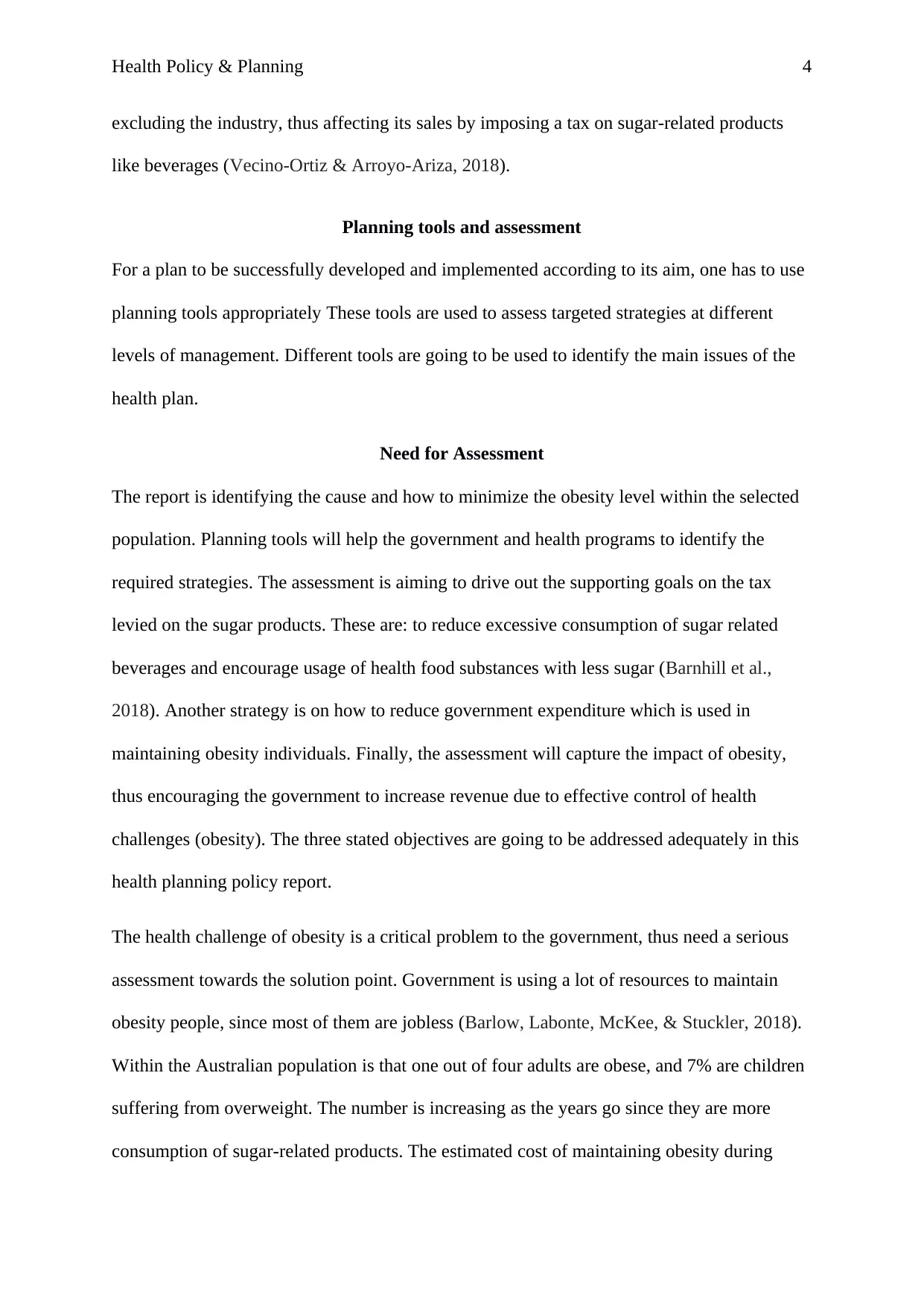
Health Policy & Planning 4
excluding the industry, thus affecting its sales by imposing a tax on sugar-related products
like beverages (Vecino-Ortiz & Arroyo-Ariza, 2018).
Planning tools and assessment
For a plan to be successfully developed and implemented according to its aim, one has to use
planning tools appropriately These tools are used to assess targeted strategies at different
levels of management. Different tools are going to be used to identify the main issues of the
health plan.
Need for Assessment
The report is identifying the cause and how to minimize the obesity level within the selected
population. Planning tools will help the government and health programs to identify the
required strategies. The assessment is aiming to drive out the supporting goals on the tax
levied on the sugar products. These are: to reduce excessive consumption of sugar related
beverages and encourage usage of health food substances with less sugar (Barnhill et al.,
2018). Another strategy is on how to reduce government expenditure which is used in
maintaining obesity individuals. Finally, the assessment will capture the impact of obesity,
thus encouraging the government to increase revenue due to effective control of health
challenges (obesity). The three stated objectives are going to be addressed adequately in this
health planning policy report.
The health challenge of obesity is a critical problem to the government, thus need a serious
assessment towards the solution point. Government is using a lot of resources to maintain
obesity people, since most of them are jobless (Barlow, Labonte, McKee, & Stuckler, 2018).
Within the Australian population is that one out of four adults are obese, and 7% are children
suffering from overweight. The number is increasing as the years go since they are more
consumption of sugar-related products. The estimated cost of maintaining obesity during
excluding the industry, thus affecting its sales by imposing a tax on sugar-related products
like beverages (Vecino-Ortiz & Arroyo-Ariza, 2018).
Planning tools and assessment
For a plan to be successfully developed and implemented according to its aim, one has to use
planning tools appropriately These tools are used to assess targeted strategies at different
levels of management. Different tools are going to be used to identify the main issues of the
health plan.
Need for Assessment
The report is identifying the cause and how to minimize the obesity level within the selected
population. Planning tools will help the government and health programs to identify the
required strategies. The assessment is aiming to drive out the supporting goals on the tax
levied on the sugar products. These are: to reduce excessive consumption of sugar related
beverages and encourage usage of health food substances with less sugar (Barnhill et al.,
2018). Another strategy is on how to reduce government expenditure which is used in
maintaining obesity individuals. Finally, the assessment will capture the impact of obesity,
thus encouraging the government to increase revenue due to effective control of health
challenges (obesity). The three stated objectives are going to be addressed adequately in this
health planning policy report.
The health challenge of obesity is a critical problem to the government, thus need a serious
assessment towards the solution point. Government is using a lot of resources to maintain
obesity people, since most of them are jobless (Barlow, Labonte, McKee, & Stuckler, 2018).
Within the Australian population is that one out of four adults are obese, and 7% are children
suffering from overweight. The number is increasing as the years go since they are more
consumption of sugar-related products. The estimated cost of maintaining obesity during
Paraphrase This Document
Need a fresh take? Get an instant paraphrase of this document with our AI Paraphraser
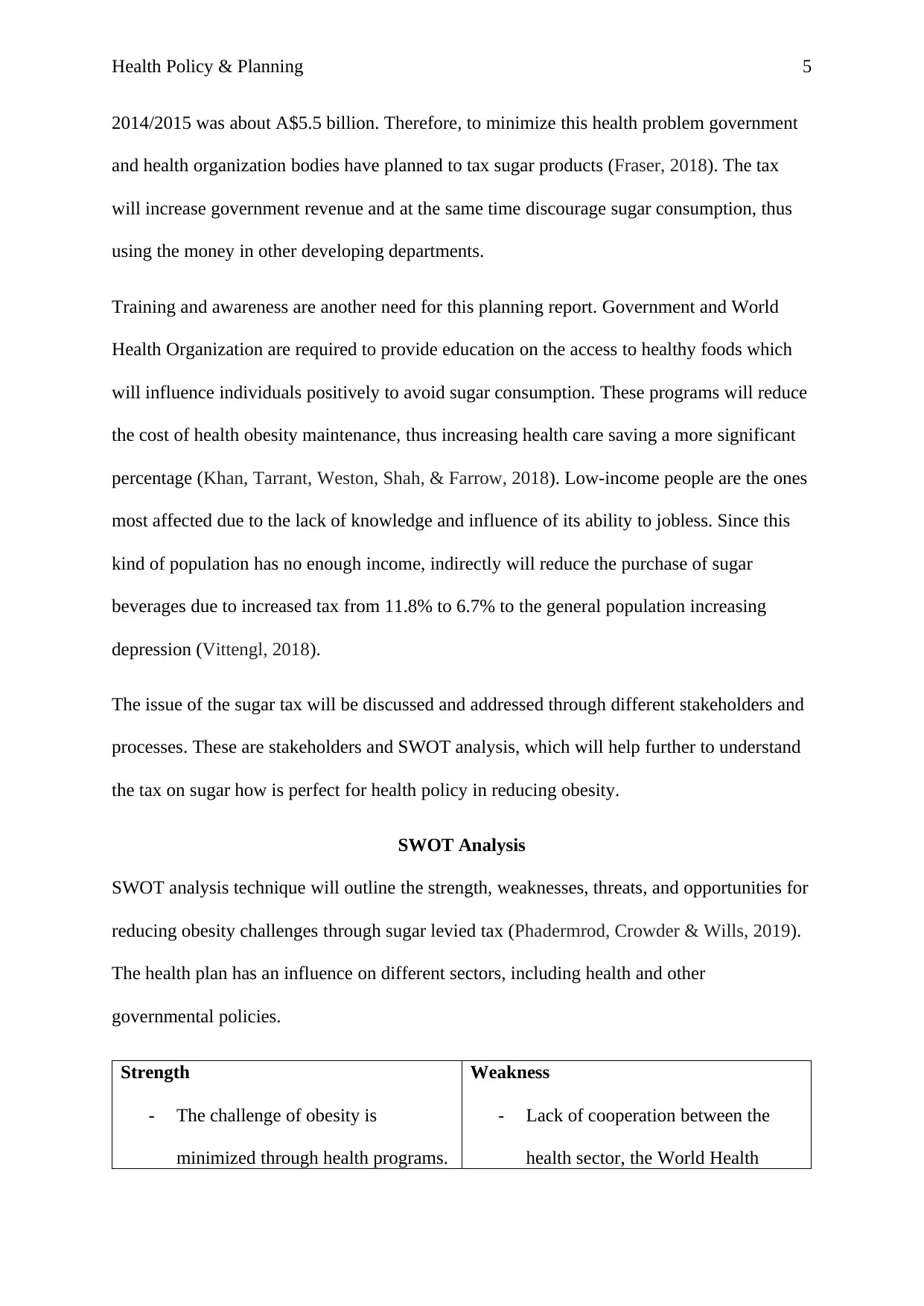
Health Policy & Planning 5
2014/2015 was about A$5.5 billion. Therefore, to minimize this health problem government
and health organization bodies have planned to tax sugar products (Fraser, 2018). The tax
will increase government revenue and at the same time discourage sugar consumption, thus
using the money in other developing departments.
Training and awareness are another need for this planning report. Government and World
Health Organization are required to provide education on the access to healthy foods which
will influence individuals positively to avoid sugar consumption. These programs will reduce
the cost of health obesity maintenance, thus increasing health care saving a more significant
percentage (Khan, Tarrant, Weston, Shah, & Farrow, 2018). Low-income people are the ones
most affected due to the lack of knowledge and influence of its ability to jobless. Since this
kind of population has no enough income, indirectly will reduce the purchase of sugar
beverages due to increased tax from 11.8% to 6.7% to the general population increasing
depression (Vittengl, 2018).
The issue of the sugar tax will be discussed and addressed through different stakeholders and
processes. These are stakeholders and SWOT analysis, which will help further to understand
the tax on sugar how is perfect for health policy in reducing obesity.
SWOT Analysis
SWOT analysis technique will outline the strength, weaknesses, threats, and opportunities for
reducing obesity challenges through sugar levied tax (Phadermrod, Crowder & Wills, 2019).
The health plan has an influence on different sectors, including health and other
governmental policies.
Strength
- The challenge of obesity is
minimized through health programs.
Weakness
- Lack of cooperation between the
health sector, the World Health
2014/2015 was about A$5.5 billion. Therefore, to minimize this health problem government
and health organization bodies have planned to tax sugar products (Fraser, 2018). The tax
will increase government revenue and at the same time discourage sugar consumption, thus
using the money in other developing departments.
Training and awareness are another need for this planning report. Government and World
Health Organization are required to provide education on the access to healthy foods which
will influence individuals positively to avoid sugar consumption. These programs will reduce
the cost of health obesity maintenance, thus increasing health care saving a more significant
percentage (Khan, Tarrant, Weston, Shah, & Farrow, 2018). Low-income people are the ones
most affected due to the lack of knowledge and influence of its ability to jobless. Since this
kind of population has no enough income, indirectly will reduce the purchase of sugar
beverages due to increased tax from 11.8% to 6.7% to the general population increasing
depression (Vittengl, 2018).
The issue of the sugar tax will be discussed and addressed through different stakeholders and
processes. These are stakeholders and SWOT analysis, which will help further to understand
the tax on sugar how is perfect for health policy in reducing obesity.
SWOT Analysis
SWOT analysis technique will outline the strength, weaknesses, threats, and opportunities for
reducing obesity challenges through sugar levied tax (Phadermrod, Crowder & Wills, 2019).
The health plan has an influence on different sectors, including health and other
governmental policies.
Strength
- The challenge of obesity is
minimized through health programs.
Weakness
- Lack of cooperation between the
health sector, the World Health
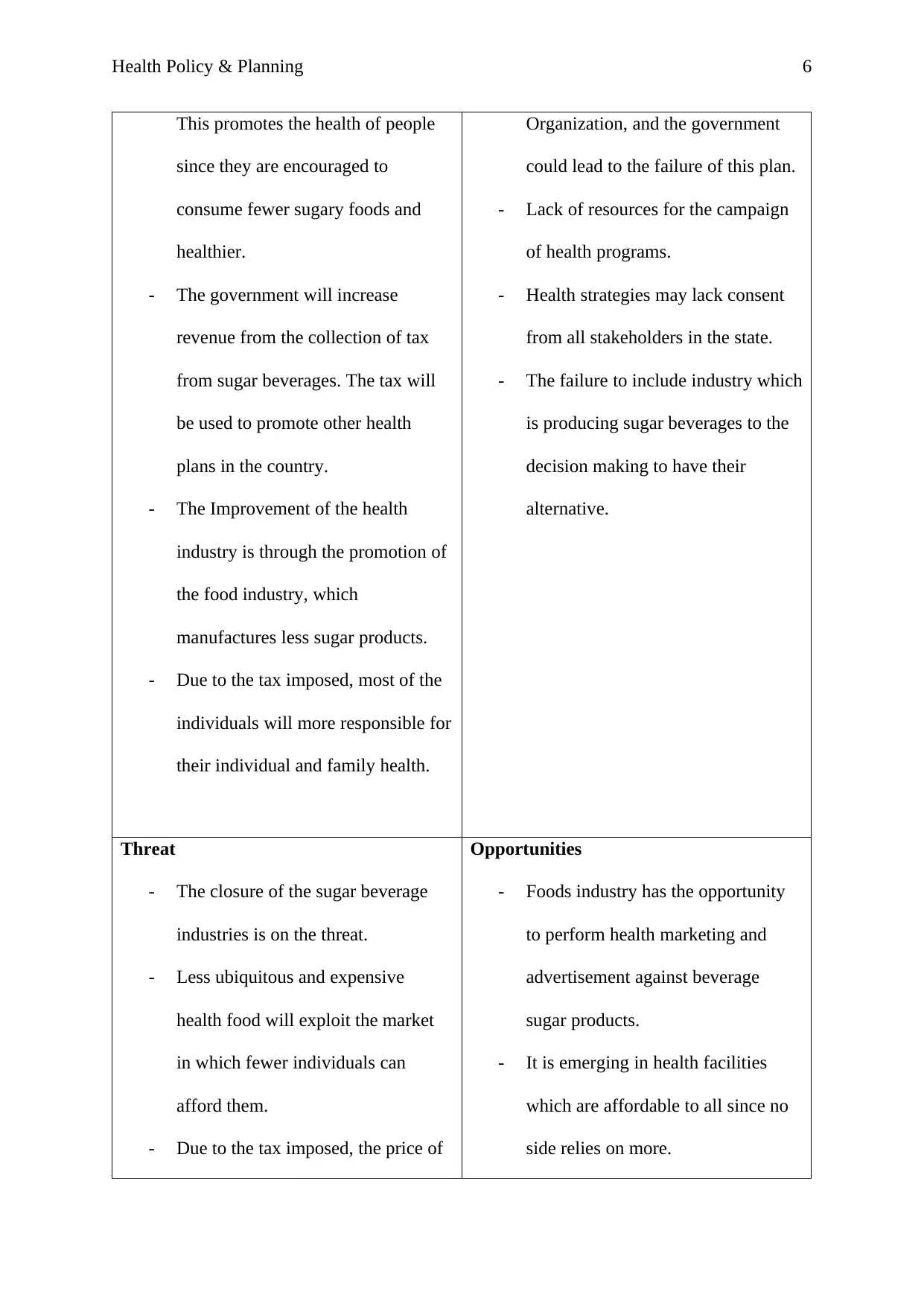
Health Policy & Planning 6
This promotes the health of people
since they are encouraged to
consume fewer sugary foods and
healthier.
- The government will increase
revenue from the collection of tax
from sugar beverages. The tax will
be used to promote other health
plans in the country.
- The Improvement of the health
industry is through the promotion of
the food industry, which
manufactures less sugar products.
- Due to the tax imposed, most of the
individuals will more responsible for
their individual and family health.
Organization, and the government
could lead to the failure of this plan.
- Lack of resources for the campaign
of health programs.
- Health strategies may lack consent
from all stakeholders in the state.
- The failure to include industry which
is producing sugar beverages to the
decision making to have their
alternative.
Threat
- The closure of the sugar beverage
industries is on the threat.
- Less ubiquitous and expensive
health food will exploit the market
in which fewer individuals can
afford them.
- Due to the tax imposed, the price of
Opportunities
- Foods industry has the opportunity
to perform health marketing and
advertisement against beverage
sugar products.
- It is emerging in health facilities
which are affordable to all since no
side relies on more.
This promotes the health of people
since they are encouraged to
consume fewer sugary foods and
healthier.
- The government will increase
revenue from the collection of tax
from sugar beverages. The tax will
be used to promote other health
plans in the country.
- The Improvement of the health
industry is through the promotion of
the food industry, which
manufactures less sugar products.
- Due to the tax imposed, most of the
individuals will more responsible for
their individual and family health.
Organization, and the government
could lead to the failure of this plan.
- Lack of resources for the campaign
of health programs.
- Health strategies may lack consent
from all stakeholders in the state.
- The failure to include industry which
is producing sugar beverages to the
decision making to have their
alternative.
Threat
- The closure of the sugar beverage
industries is on the threat.
- Less ubiquitous and expensive
health food will exploit the market
in which fewer individuals can
afford them.
- Due to the tax imposed, the price of
Opportunities
- Foods industry has the opportunity
to perform health marketing and
advertisement against beverage
sugar products.
- It is emerging in health facilities
which are affordable to all since no
side relies on more.
⊘ This is a preview!⊘
Do you want full access?
Subscribe today to unlock all pages.

Trusted by 1+ million students worldwide
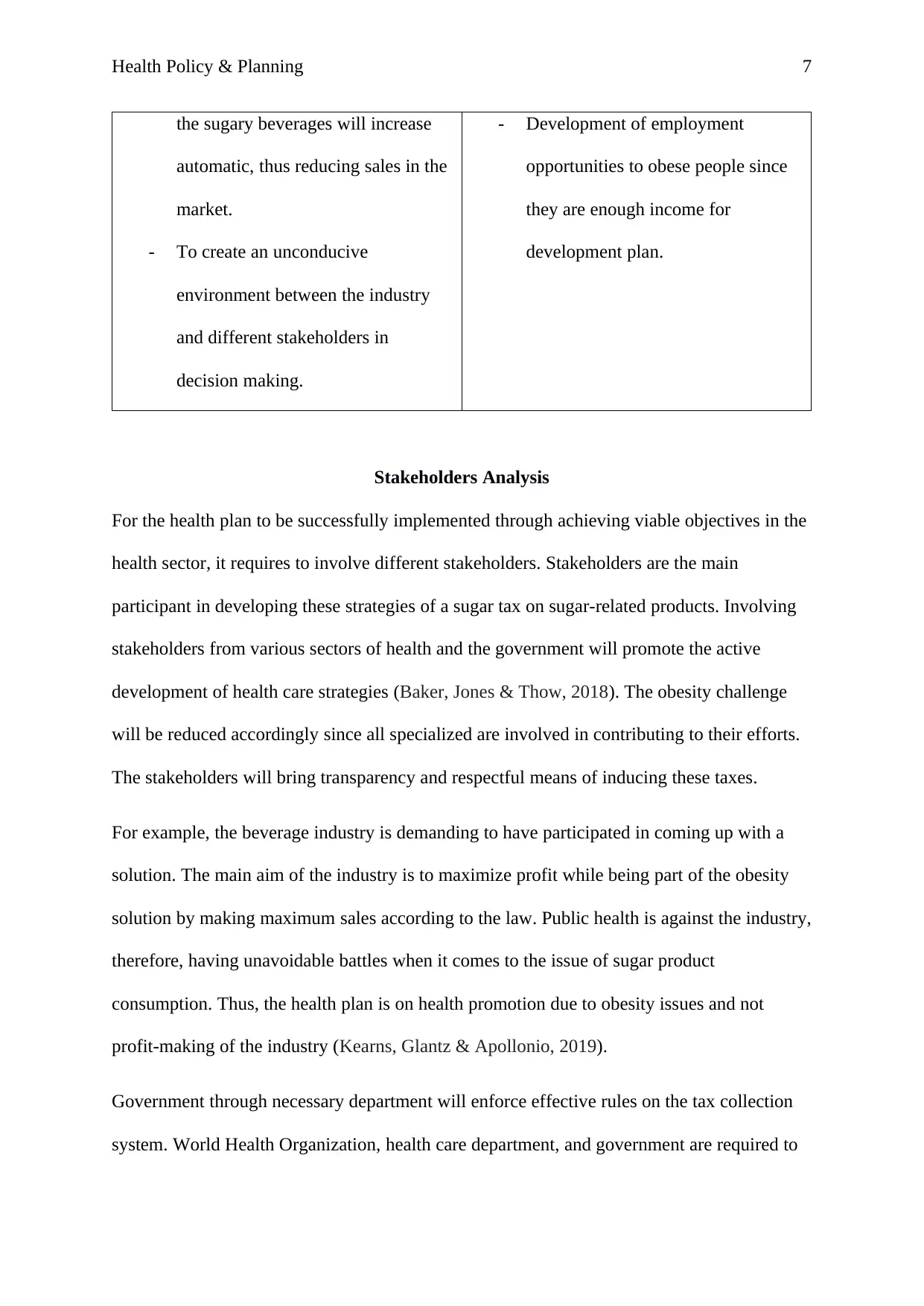
Health Policy & Planning 7
the sugary beverages will increase
automatic, thus reducing sales in the
market.
- To create an unconducive
environment between the industry
and different stakeholders in
decision making.
- Development of employment
opportunities to obese people since
they are enough income for
development plan.
Stakeholders Analysis
For the health plan to be successfully implemented through achieving viable objectives in the
health sector, it requires to involve different stakeholders. Stakeholders are the main
participant in developing these strategies of a sugar tax on sugar-related products. Involving
stakeholders from various sectors of health and the government will promote the active
development of health care strategies (Baker, Jones & Thow, 2018). The obesity challenge
will be reduced accordingly since all specialized are involved in contributing to their efforts.
The stakeholders will bring transparency and respectful means of inducing these taxes.
For example, the beverage industry is demanding to have participated in coming up with a
solution. The main aim of the industry is to maximize profit while being part of the obesity
solution by making maximum sales according to the law. Public health is against the industry,
therefore, having unavoidable battles when it comes to the issue of sugar product
consumption. Thus, the health plan is on health promotion due to obesity issues and not
profit-making of the industry (Kearns, Glantz & Apollonio, 2019).
Government through necessary department will enforce effective rules on the tax collection
system. World Health Organization, health care department, and government are required to
the sugary beverages will increase
automatic, thus reducing sales in the
market.
- To create an unconducive
environment between the industry
and different stakeholders in
decision making.
- Development of employment
opportunities to obese people since
they are enough income for
development plan.
Stakeholders Analysis
For the health plan to be successfully implemented through achieving viable objectives in the
health sector, it requires to involve different stakeholders. Stakeholders are the main
participant in developing these strategies of a sugar tax on sugar-related products. Involving
stakeholders from various sectors of health and the government will promote the active
development of health care strategies (Baker, Jones & Thow, 2018). The obesity challenge
will be reduced accordingly since all specialized are involved in contributing to their efforts.
The stakeholders will bring transparency and respectful means of inducing these taxes.
For example, the beverage industry is demanding to have participated in coming up with a
solution. The main aim of the industry is to maximize profit while being part of the obesity
solution by making maximum sales according to the law. Public health is against the industry,
therefore, having unavoidable battles when it comes to the issue of sugar product
consumption. Thus, the health plan is on health promotion due to obesity issues and not
profit-making of the industry (Kearns, Glantz & Apollonio, 2019).
Government through necessary department will enforce effective rules on the tax collection
system. World Health Organization, health care department, and government are required to
Paraphrase This Document
Need a fresh take? Get an instant paraphrase of this document with our AI Paraphraser
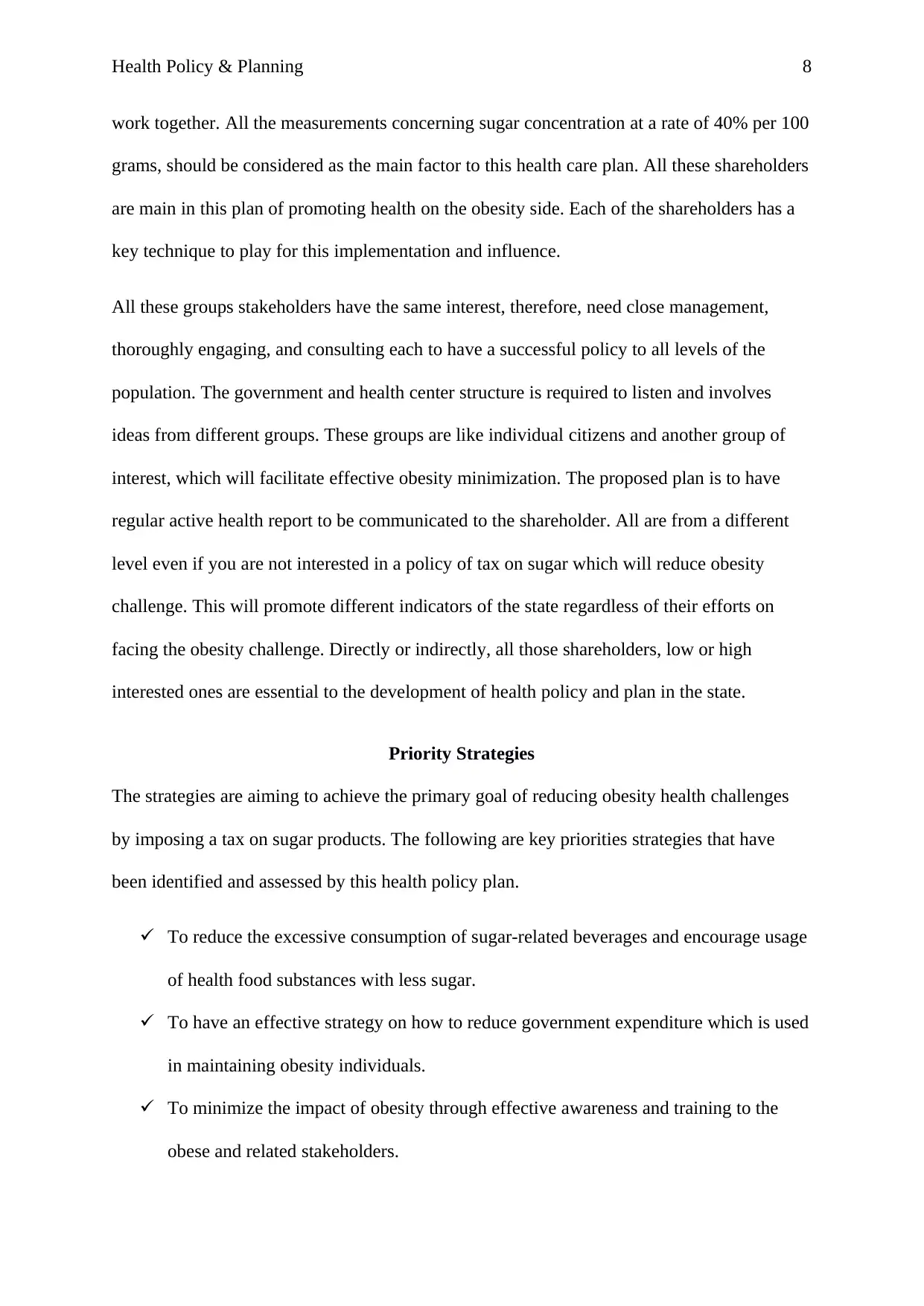
Health Policy & Planning 8
work together. All the measurements concerning sugar concentration at a rate of 40% per 100
grams, should be considered as the main factor to this health care plan. All these shareholders
are main in this plan of promoting health on the obesity side. Each of the shareholders has a
key technique to play for this implementation and influence.
All these groups stakeholders have the same interest, therefore, need close management,
thoroughly engaging, and consulting each to have a successful policy to all levels of the
population. The government and health center structure is required to listen and involves
ideas from different groups. These groups are like individual citizens and another group of
interest, which will facilitate effective obesity minimization. The proposed plan is to have
regular active health report to be communicated to the shareholder. All are from a different
level even if you are not interested in a policy of tax on sugar which will reduce obesity
challenge. This will promote different indicators of the state regardless of their efforts on
facing the obesity challenge. Directly or indirectly, all those shareholders, low or high
interested ones are essential to the development of health policy and plan in the state.
Priority Strategies
The strategies are aiming to achieve the primary goal of reducing obesity health challenges
by imposing a tax on sugar products. The following are key priorities strategies that have
been identified and assessed by this health policy plan.
To reduce the excessive consumption of sugar-related beverages and encourage usage
of health food substances with less sugar.
To have an effective strategy on how to reduce government expenditure which is used
in maintaining obesity individuals.
To minimize the impact of obesity through effective awareness and training to the
obese and related stakeholders.
work together. All the measurements concerning sugar concentration at a rate of 40% per 100
grams, should be considered as the main factor to this health care plan. All these shareholders
are main in this plan of promoting health on the obesity side. Each of the shareholders has a
key technique to play for this implementation and influence.
All these groups stakeholders have the same interest, therefore, need close management,
thoroughly engaging, and consulting each to have a successful policy to all levels of the
population. The government and health center structure is required to listen and involves
ideas from different groups. These groups are like individual citizens and another group of
interest, which will facilitate effective obesity minimization. The proposed plan is to have
regular active health report to be communicated to the shareholder. All are from a different
level even if you are not interested in a policy of tax on sugar which will reduce obesity
challenge. This will promote different indicators of the state regardless of their efforts on
facing the obesity challenge. Directly or indirectly, all those shareholders, low or high
interested ones are essential to the development of health policy and plan in the state.
Priority Strategies
The strategies are aiming to achieve the primary goal of reducing obesity health challenges
by imposing a tax on sugar products. The following are key priorities strategies that have
been identified and assessed by this health policy plan.
To reduce the excessive consumption of sugar-related beverages and encourage usage
of health food substances with less sugar.
To have an effective strategy on how to reduce government expenditure which is used
in maintaining obesity individuals.
To minimize the impact of obesity through effective awareness and training to the
obese and related stakeholders.
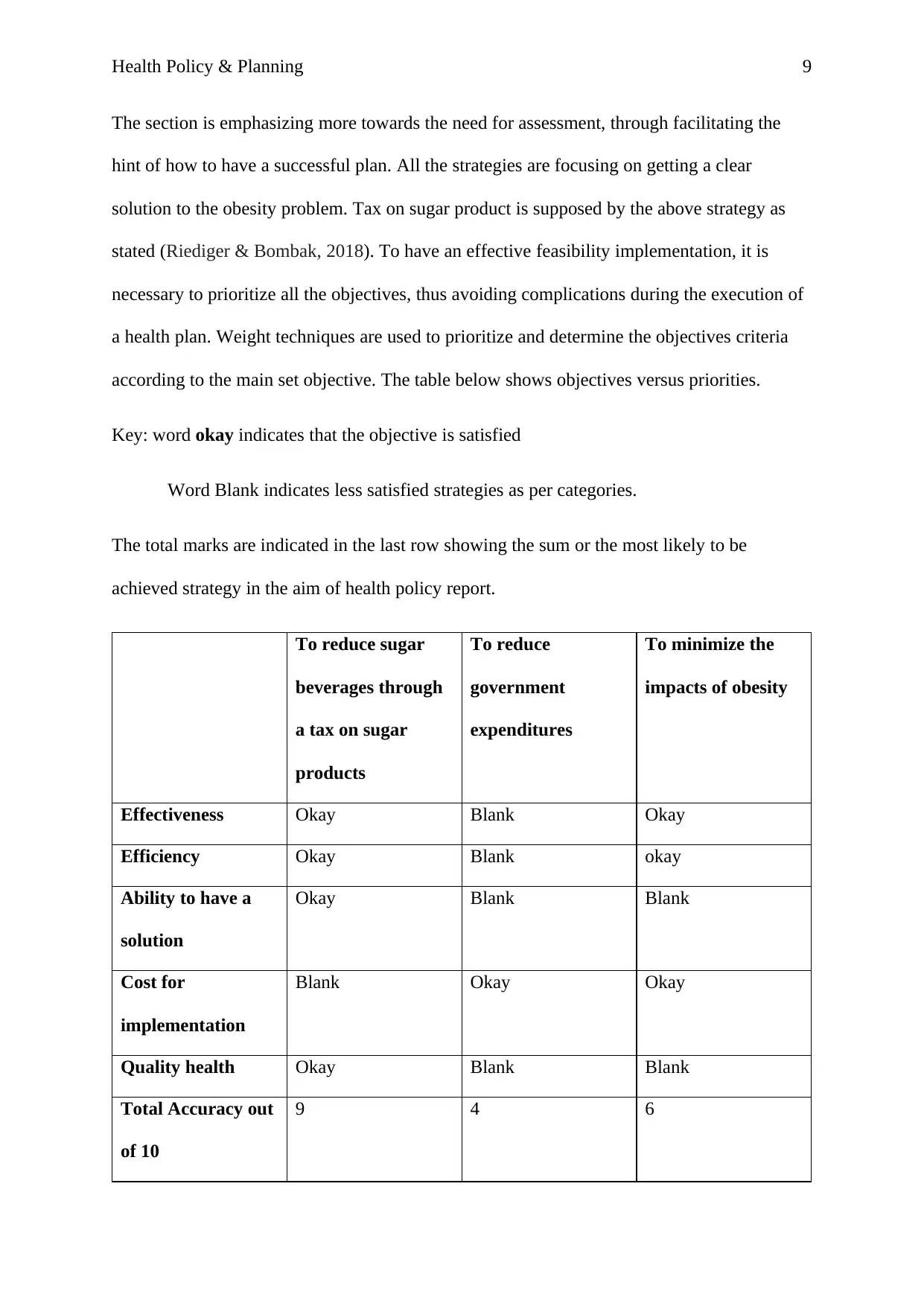
Health Policy & Planning 9
The section is emphasizing more towards the need for assessment, through facilitating the
hint of how to have a successful plan. All the strategies are focusing on getting a clear
solution to the obesity problem. Tax on sugar product is supposed by the above strategy as
stated (Riediger & Bombak, 2018). To have an effective feasibility implementation, it is
necessary to prioritize all the objectives, thus avoiding complications during the execution of
a health plan. Weight techniques are used to prioritize and determine the objectives criteria
according to the main set objective. The table below shows objectives versus priorities.
Key: word okay indicates that the objective is satisfied
Word Blank indicates less satisfied strategies as per categories.
The total marks are indicated in the last row showing the sum or the most likely to be
achieved strategy in the aim of health policy report.
To reduce sugar
beverages through
a tax on sugar
products
To reduce
government
expenditures
To minimize the
impacts of obesity
Effectiveness Okay Blank Okay
Efficiency Okay Blank okay
Ability to have a
solution
Okay Blank Blank
Cost for
implementation
Blank Okay Okay
Quality health Okay Blank Blank
Total Accuracy out
of 10
9 4 6
The section is emphasizing more towards the need for assessment, through facilitating the
hint of how to have a successful plan. All the strategies are focusing on getting a clear
solution to the obesity problem. Tax on sugar product is supposed by the above strategy as
stated (Riediger & Bombak, 2018). To have an effective feasibility implementation, it is
necessary to prioritize all the objectives, thus avoiding complications during the execution of
a health plan. Weight techniques are used to prioritize and determine the objectives criteria
according to the main set objective. The table below shows objectives versus priorities.
Key: word okay indicates that the objective is satisfied
Word Blank indicates less satisfied strategies as per categories.
The total marks are indicated in the last row showing the sum or the most likely to be
achieved strategy in the aim of health policy report.
To reduce sugar
beverages through
a tax on sugar
products
To reduce
government
expenditures
To minimize the
impacts of obesity
Effectiveness Okay Blank Okay
Efficiency Okay Blank okay
Ability to have a
solution
Okay Blank Blank
Cost for
implementation
Blank Okay Okay
Quality health Okay Blank Blank
Total Accuracy out
of 10
9 4 6
⊘ This is a preview!⊘
Do you want full access?
Subscribe today to unlock all pages.

Trusted by 1+ million students worldwide
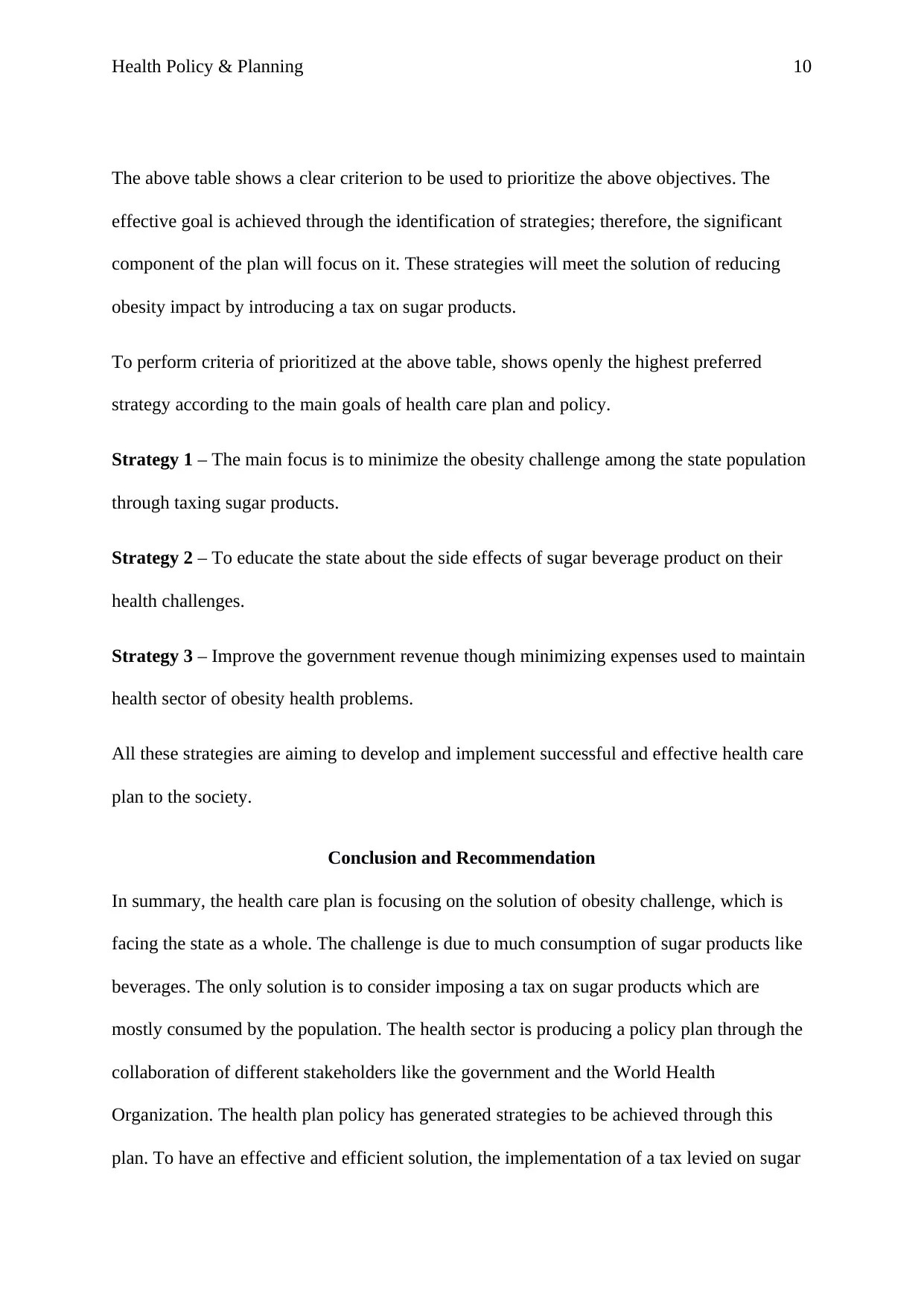
Health Policy & Planning 10
The above table shows a clear criterion to be used to prioritize the above objectives. The
effective goal is achieved through the identification of strategies; therefore, the significant
component of the plan will focus on it. These strategies will meet the solution of reducing
obesity impact by introducing a tax on sugar products.
To perform criteria of prioritized at the above table, shows openly the highest preferred
strategy according to the main goals of health care plan and policy.
Strategy 1 – The main focus is to minimize the obesity challenge among the state population
through taxing sugar products.
Strategy 2 – To educate the state about the side effects of sugar beverage product on their
health challenges.
Strategy 3 – Improve the government revenue though minimizing expenses used to maintain
health sector of obesity health problems.
All these strategies are aiming to develop and implement successful and effective health care
plan to the society.
Conclusion and Recommendation
In summary, the health care plan is focusing on the solution of obesity challenge, which is
facing the state as a whole. The challenge is due to much consumption of sugar products like
beverages. The only solution is to consider imposing a tax on sugar products which are
mostly consumed by the population. The health sector is producing a policy plan through the
collaboration of different stakeholders like the government and the World Health
Organization. The health plan policy has generated strategies to be achieved through this
plan. To have an effective and efficient solution, the implementation of a tax levied on sugar
The above table shows a clear criterion to be used to prioritize the above objectives. The
effective goal is achieved through the identification of strategies; therefore, the significant
component of the plan will focus on it. These strategies will meet the solution of reducing
obesity impact by introducing a tax on sugar products.
To perform criteria of prioritized at the above table, shows openly the highest preferred
strategy according to the main goals of health care plan and policy.
Strategy 1 – The main focus is to minimize the obesity challenge among the state population
through taxing sugar products.
Strategy 2 – To educate the state about the side effects of sugar beverage product on their
health challenges.
Strategy 3 – Improve the government revenue though minimizing expenses used to maintain
health sector of obesity health problems.
All these strategies are aiming to develop and implement successful and effective health care
plan to the society.
Conclusion and Recommendation
In summary, the health care plan is focusing on the solution of obesity challenge, which is
facing the state as a whole. The challenge is due to much consumption of sugar products like
beverages. The only solution is to consider imposing a tax on sugar products which are
mostly consumed by the population. The health sector is producing a policy plan through the
collaboration of different stakeholders like the government and the World Health
Organization. The health plan policy has generated strategies to be achieved through this
plan. To have an effective and efficient solution, the implementation of a tax levied on sugar
Paraphrase This Document
Need a fresh take? Get an instant paraphrase of this document with our AI Paraphraser
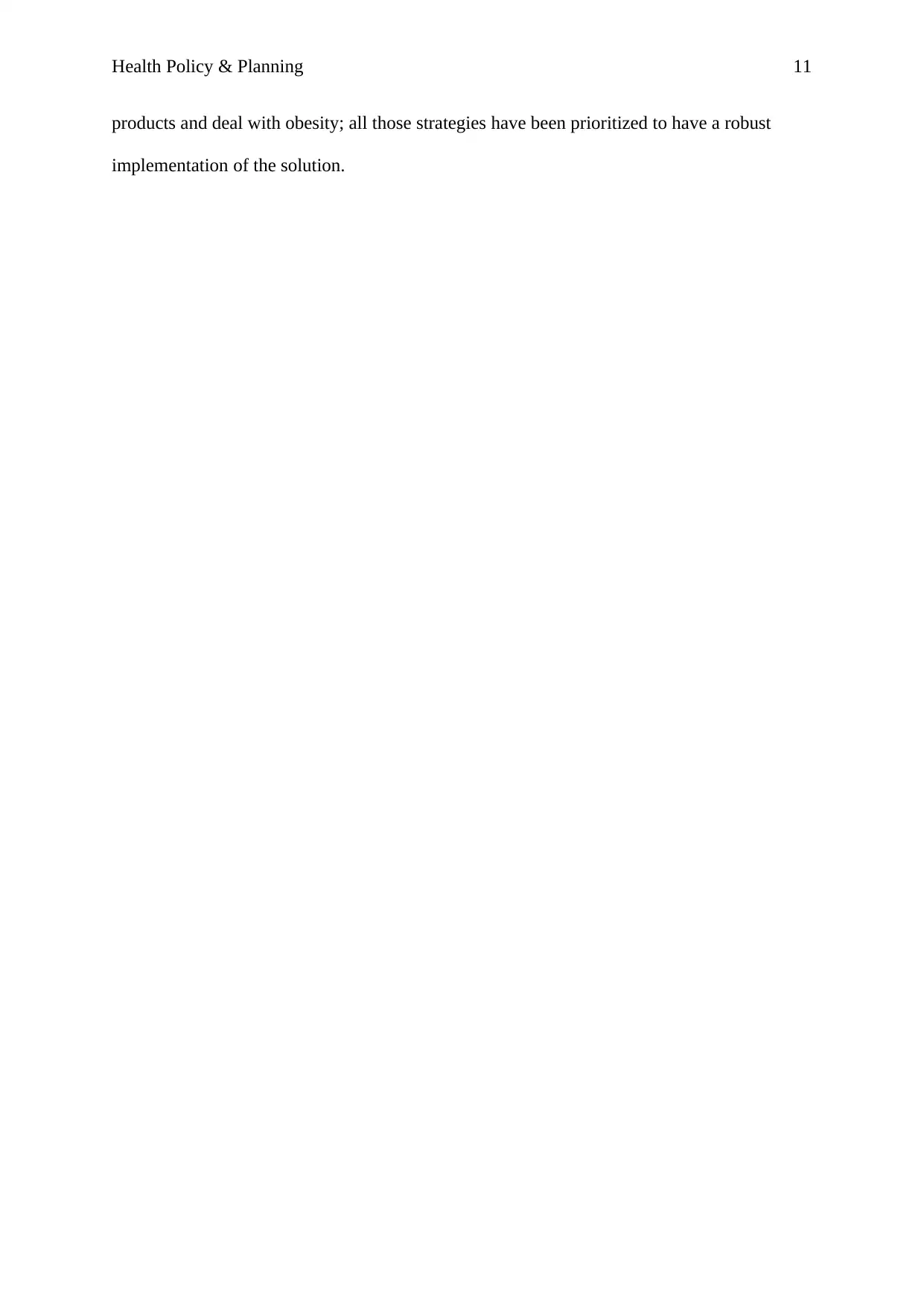
Health Policy & Planning 11
products and deal with obesity; all those strategies have been prioritized to have a robust
implementation of the solution.
products and deal with obesity; all those strategies have been prioritized to have a robust
implementation of the solution.
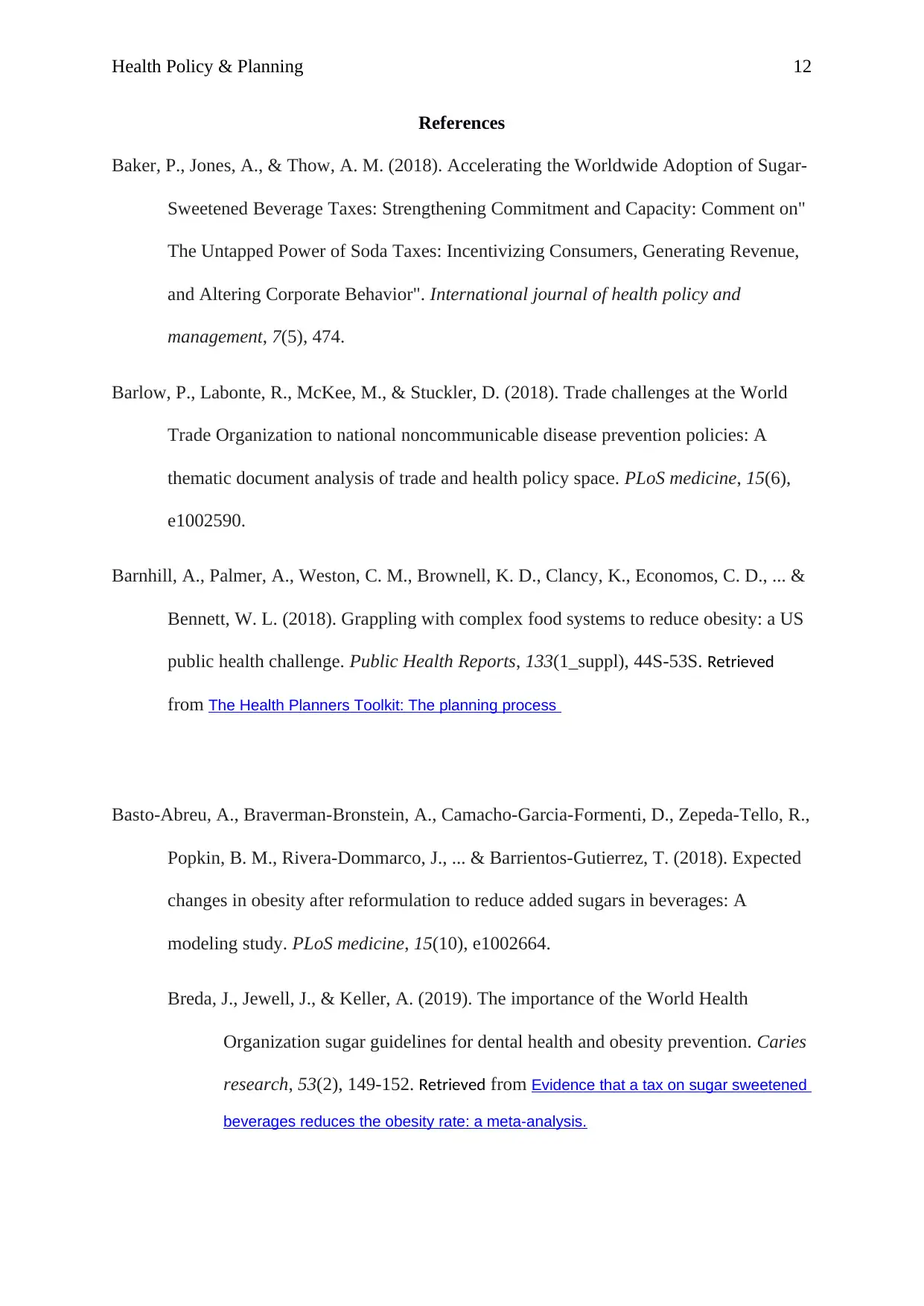
Health Policy & Planning 12
References
Baker, P., Jones, A., & Thow, A. M. (2018). Accelerating the Worldwide Adoption of Sugar-
Sweetened Beverage Taxes: Strengthening Commitment and Capacity: Comment on"
The Untapped Power of Soda Taxes: Incentivizing Consumers, Generating Revenue,
and Altering Corporate Behavior". International journal of health policy and
management, 7(5), 474.
Barlow, P., Labonte, R., McKee, M., & Stuckler, D. (2018). Trade challenges at the World
Trade Organization to national noncommunicable disease prevention policies: A
thematic document analysis of trade and health policy space. PLoS medicine, 15(6),
e1002590.
Barnhill, A., Palmer, A., Weston, C. M., Brownell, K. D., Clancy, K., Economos, C. D., ... &
Bennett, W. L. (2018). Grappling with complex food systems to reduce obesity: a US
public health challenge. Public Health Reports, 133(1_suppl), 44S-53S. Retrieved
from The Health Planners Toolkit: The planning process
Basto-Abreu, A., Braverman-Bronstein, A., Camacho-Garcia-Formenti, D., Zepeda-Tello, R.,
Popkin, B. M., Rivera-Dommarco, J., ... & Barrientos-Gutierrez, T. (2018). Expected
changes in obesity after reformulation to reduce added sugars in beverages: A
modeling study. PLoS medicine, 15(10), e1002664.
Breda, J., Jewell, J., & Keller, A. (2019). The importance of the World Health
Organization sugar guidelines for dental health and obesity prevention. Caries
research, 53(2), 149-152. Retrieved from Evidence that a tax on sugar sweetened
beverages reduces the obesity rate: a meta-analysis.
References
Baker, P., Jones, A., & Thow, A. M. (2018). Accelerating the Worldwide Adoption of Sugar-
Sweetened Beverage Taxes: Strengthening Commitment and Capacity: Comment on"
The Untapped Power of Soda Taxes: Incentivizing Consumers, Generating Revenue,
and Altering Corporate Behavior". International journal of health policy and
management, 7(5), 474.
Barlow, P., Labonte, R., McKee, M., & Stuckler, D. (2018). Trade challenges at the World
Trade Organization to national noncommunicable disease prevention policies: A
thematic document analysis of trade and health policy space. PLoS medicine, 15(6),
e1002590.
Barnhill, A., Palmer, A., Weston, C. M., Brownell, K. D., Clancy, K., Economos, C. D., ... &
Bennett, W. L. (2018). Grappling with complex food systems to reduce obesity: a US
public health challenge. Public Health Reports, 133(1_suppl), 44S-53S. Retrieved
from The Health Planners Toolkit: The planning process
Basto-Abreu, A., Braverman-Bronstein, A., Camacho-Garcia-Formenti, D., Zepeda-Tello, R.,
Popkin, B. M., Rivera-Dommarco, J., ... & Barrientos-Gutierrez, T. (2018). Expected
changes in obesity after reformulation to reduce added sugars in beverages: A
modeling study. PLoS medicine, 15(10), e1002664.
Breda, J., Jewell, J., & Keller, A. (2019). The importance of the World Health
Organization sugar guidelines for dental health and obesity prevention. Caries
research, 53(2), 149-152. Retrieved from Evidence that a tax on sugar sweetened
beverages reduces the obesity rate: a meta-analysis.
⊘ This is a preview!⊘
Do you want full access?
Subscribe today to unlock all pages.

Trusted by 1+ million students worldwide
1 out of 15
Related Documents
Your All-in-One AI-Powered Toolkit for Academic Success.
+13062052269
info@desklib.com
Available 24*7 on WhatsApp / Email
![[object Object]](/_next/static/media/star-bottom.7253800d.svg)
Unlock your academic potential
Copyright © 2020–2025 A2Z Services. All Rights Reserved. Developed and managed by ZUCOL.





